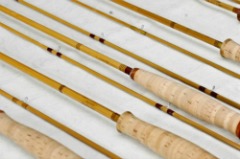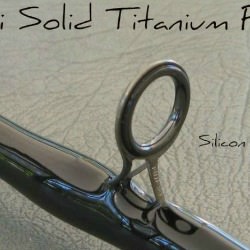Tips and Information About
Fishing Rods And Fishing Poles
There are quite a few theories as to how and when fishing rods have developed since the beginning.
However, it's safe to say that the first rods to fish with were made from sticks and limbs from tree branches. Would you agree?
It's obvious that fishing poles have evolved drastically since the cave man days of way back then.
There are six kinds of materials that fishing poles are most commonly crafted with, which we have listed below.
 Ancient Fishing from the old days with a Bamboo Cane Pole
Ancient Fishing from the old days with a Bamboo Cane PoleWe have put together an array of tips to help you with selecting a new rod, and extensive reviews under the categories for specific fish species, top name brands, different types, and accessories.
6 Composite Materials For Crafting Fishing Poles
Bamboo Fishing Poles

Anglers began incorporating the use of bamboo. By the mid 1800's, they started attaching strips of flexible cane bamboo tips onto their rods. They would use about three or four strips of the bamboo. The better poles were tapered and often made from hard durable wood such as hickory.
As with anything else, improvements were made through experimentation and through the evolution of technology. To build better rods, the amount of bamboo used would increase, eventually leading to eight strips of bamboo, now known as the classic eight-strip laminated style.
Boron Fishing Poles

Boron is a very light metallic filament, lighter than aluminum, that is five times as strong and twice as stiff as steel.
Boron has been making a strong push to be an alternative to graphite. Many fishermen feel that boron is better than graphite because of its sensitivity and strength, including the reduction of the weight of rods.
Fiberglass Fishing Poles
The World War II era brought forth the introduction to the fiberglass fishing poles. This included two techniques:
- One consisted of glass fibers saturated in cloth wrapped around steel templates for size and taper.
- The other wraps glass fibers around a light wood core with cellophane film before being heated.
Graphite Fishing Poles

Graphite was invented by Britain for aerospace technology. High modulus graphite fishing rods were introduced to the fishing world by Fenwick in 1973.
Graphite is a carbon fiber which comes from the residue of crude oil, post-refining sludge that is extruded into poly acrylic nitrate fibers. There follows a series of baking operations and other procedures to accomplish the making of graphite rods.
Graphite weighs two-thirds less and is ten times stronger than fiberglass. Pure graphite is too brittle though, so most often, graphite fishing rods will contain a small percentage of another material, usually fiberglass.
Kevlar Fishing Poles
Kevlar is one of the latest insertions from the space age of rod manufacturing. It's light weight, stiff and strong, with fast actions, and superb sensitivity. It provides the power needed to fight winds and battling it out with those feisty fish.
Titanium Fishing Poles

Titanium is one of the latest composites to be successfully incorporated into rod making. The rod building industry began using titanium right around the turn of the century.
Now that the mass competition has caught on to this new material, many manufacturers claim that their products are better than the rest. The push to design and create the lightest, strongest, and most sensitive rod has met a high standard of excellence with this latest innovation.
As technological advancements vastly revolutionize
the world of rod building, we shall patiently wait to see "the next
great thing" to hit the fishing tackle world by surprise.
More Fishing Rod Selection Tips

Some rod blanks are constructed solely of just one of the types of materials listed above, while many other types of fishing poles are made with a combination of those substances.
The best built rods (especially those being manufactured nowadays) contain materials that provide light weight, durable strength and toughness, and the sensitivity to better suit the desires of the fishermen.
It is argumentative, of course, as to which kinds of fishing
rods are the best. It also goes to say which is better suited for each
style and type of fishing, or saltwater and freshwater fishing.
Rod Action and Rod Power
Rods are classified into groups and categories.
So, these are a few things to consider when selecting the right one for
the battle field. One
of the major things to consider is the action and
power that freshwater fishing rods
provide.






Facebook Comments
Leave a comment, question or tip in the box below.